Index
Conclusion – twice the performance of traditional 802.11ac with the right hardware
The biggest drawback to our testing of the Linksys WRT3200ACM router was the lack of any client 802.11ac adapters with support for 160MHz channels. As mentioned previously, Intel just announced its 5th generation 802.11ac adapters last month and they are expected to become available later this summer. When they do, we can expect to utilize the router’s full support for MU-MIMO at up to 1.73Gbps, which is double the speed at which we can connect for now (867Mbps).
The overall design of the WRT3200ACM is very reminiscent of the classic WRT54G from 2002 that dominated store shelves for over a decade, though the product is more of a direct successor to an earlier 802.11ac release, the Linksys WRT1900ACS. The company has not skimped out on processing power by any means, packing its latest WRT with a robust dual-core 1.8GHz Marvell Armada 385 (Cortex A9-based), and another Cortex A9-based Marvell Avastar 4 x 4 MIMO dual-band chipset with support for beamforming and Tri-Stream 160MHz.
In our testing on three 80MHz 802.11ac client devices, we were not able to even come near the theoretical 2600Mbps speeds on the 5GHz band. By running twenty simultaneous data streams across two notebooks and an iPhone 6, we were able to reach a maximum of 115Mbps in our MU-MIMO testing environment. With just two notebooks connected, we saw a combined 102.4Mbps of throughput, and with a single device we reached 63.3Mbps on channel 56. Meanwhile, our iPhone saw an average throughput rate of 70Mbps with 12ms of latency.
Depending on the surrounding environment, 5GHz channel choice can be a very important decision. We tested all available channels and discovered that 56 and 116 were produced the most consistent throughput curves on our charts, though mileage may vary.
Performance was also very consistent in mixed 802.11ac/n mode with both radios enabled. Our graphs show a combined throughput between all three devices at 100Mbps, which is on par with our 802.11ac-only results.
On the other hand, 2.4GHz performance over 802.11n was above par compared to most other routers on the market. We were able to get 28.48Mbps in our jperf test, followed by 27Mbps in 20MHz only mode.
The Linksys WRT3200ACM offers a lot in terms of customization with support for open-sourced DD-WRT and OpenWRT firmware packages. We did not have a chance a custom package on our review sample but suspect that a few very useful performance metrics can be adjusted even further, such as latency, buffer improvements, and transmit power. For a price of just $199, this router offers the top performance on the market with support for 160MHz channel width, despite the fact that no client devices will be capable of supporting it until later this summer. As of now, the WRT1900ACS is only $20 cheaper at $179.97, making this Tri-Stream router an investment in the future for users who don’t necessarily have the cash to upgrade all of their client devices.
802.11ac 160MHz is promising – should you be concerned about 802.11ax?
On the horizon is 802.11ax technology, which was introduced in a pair of chipsets from Qualcomm and Quantenna earlier in February. The technology is predicted to have a top speed of around 10Gbps, but the standard is not expected to be ratified until sometime in 2019. For now, most users upgrading to 802.11ac Wave 2 will be able to enjoy top speeds of 1.67Gbps with the introduction of 160MHz channel widths. In fact, Qualcomm is only promising 1.775Gbps with its first-gen 802.11ax hardware. So while the predicted sixfold improvement in speed is promising, the technology is still at least four years away for most consumers.





